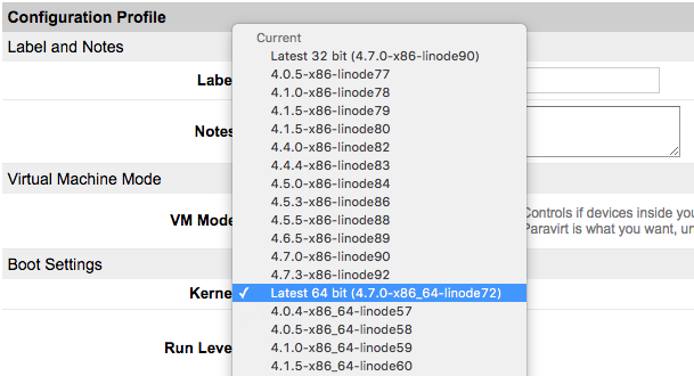Switch to a 64-bit Linux Kernel
Traducciones al EspañolEstamos traduciendo nuestros guías y tutoriales al Español. Es posible que usted esté viendo una traducción generada automáticamente. Estamos trabajando con traductores profesionales para verificar las traducciones de nuestro sitio web. Este proyecto es un trabajo en curso.
Before an existing Linode can be migrated to a new host, you’ll need to ensure that all configuration profiles on that Linode are using a 64-bit kernel. This guide will show you how to make that switch, and warn about some of the more common issues to look out for in the process.


Switch to a 64-bit Kernel
Next to your Configuration Profile, click Edit.
Under
Boot Settingsclick on the Kernel drop down. Select theLatest 64 bitoption.Press Save Changes, which will take you back to your Linode Dashboard. Now reboot your Linode.
Considerations
Switching to a 64-bit kernel does not mean you now have a 64-bit deployment of Linux. Until you redeploy, your user space and libraries will still be 32-bit. The 64-bit kernel will happily run software designed for 32-bit, but specific pieces of software may conflict with the new kernel.
The following is a list of software with known issues running on a 32-bit distribution with a 64-bit kernel. If you rely on any of these packages, we suggest a rebuild to a 64-bit distribution.
- Xtables
- OpeniSCSI
- Java
If you’re ready to rebuild your Linode using a 64-bit distribution, you can start by following the steps to create a new disk and configuration profile in the Managing Disks and Storage on a Linode and Managing Configuration Profiles on a Linode guide. After a new disk and configuration profile has been created, you can copy your data to the new 64-bit version and then delete your old profile and disks.
Otherwise, find your Linux distribution of choice below to check for additional known issues.
Ubuntu and Debian
For Ubuntu and Debian users, the Apt package management system will continue to download correct architecture version of software, despite the new kernel.
CentOS and Fedora
When switching a 32-bit CentOS or Fedora build to use a 64-bit kernel, you need to configure the distro’s package manager (Yum) to explicitly download x86 architecture builds of updates to existing and new packages. If you haven’t already, we recommend CentOS users switch to the package mirrors Linode provides. The instructions to switch to Linode’s package mirrors are in the package mirrors guide. Regardless of your decision to use our mirrors, you will want to run this command to ensure that only 32-bit packages are selected:
sed -i 's/$basearch/i386/g' /etc/yum.repos.d/*
Once this is done, run a cleanup of yum:
yum clean all
Now all future software installed from Yum will use the correct CPU architecture for your 32-bit user space.
Arch Linux
The Arch package manager, Pacman, chooses what architecture-specific builds to download based on the kernel. After switching to the 64-bit kernel, adjust this setting in /etc/pacman.conf:
- File: /etc/pacman.conf
1Architecture=x86_64
Gentoo
In Gentoo, all packages are compiled on the system. Ensure that the -m32 flag is set in CFLAGS.
More Information
You may wish to consult the following resources for additional information on this topic. While these are provided in the hope that they will be useful, please note that we cannot vouch for the accuracy or timeliness of externally hosted materials.
This page was originally published on










